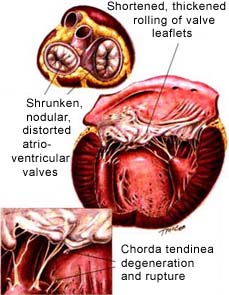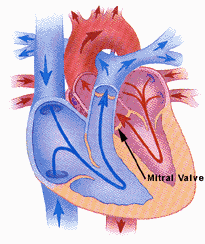Endocardiosis
Endocardiosis is the most common cause of heart failure in dogs. The disease is a chronic degenerative disorder of the mitral and tricuspid heart valves. Of the two valves, the most commonly affected is the mitral valve. Isolated degenerative lesions of the tricuspid valve are rare; however, both valves are affected in many dogs.
The mitral valve is located between the left atrium and the left ventricle. As lesions of endocardiosis progress, the valves become deformed, thickened, and weak. Eventually, the valves become incompetent.

Chronic Valvular Disease
Development of symptoms due to endocardiosis generally occur slowly. Since the mitral valve is not functioning properly, the normal blood flow (from the left auricle to the left ventricle then out the aorta) is affected.

Normal Heart
red = oxygenated blood
blue= unoxygenated blood
In a normal heart, the blood is pumped from the left atrium to the left ventricle. After the blood reaches the left ventricle, it is pumped forward to the aorta. With endocardiosis of the mitral valve, some of the blood is regurgitated back from the ventricle to the atrium. The left ventricle and left atrium eventually dilate in order to accept this regurgitated blood. As valve degeneration progresses, more blood is regurgitated back to the atrium, diminishing the forward flow of blood into the aorta.
Some dogs with endocardiosis of the mitral valve never show symptoms of heart disease. Others cannot compensate and eventually show symptoms of heart failure.
Decreased exercise tolerance and cough with exertion are the most common symptoms. As fluid buildup in the lungs increases, the cough gets worse. In severe cases, fainting (acute collapse) occurs.
A dog exhibiting symptoms of heart disease should be examined by a veterinarian. Laboratory tests, X-rays, ECG, and cardiac ultrasound are diagnostic tools that are helpful in diagnosing heart problems.
Presently, heart valve transplants do not exist in dogs. Medical treatment is available for dogs exhibiting symptoms due to endocardiosis.
These lesions are extremely rare in cats.
[ Search Articles ] [ Article Index ] [ Previous Page ]